In her renowned book, Trauma and Recovery, Judith Herman explored the relationship between sexual abuse and political power and proposed that a person who has been traumatised needs a therapy that privileges safety, allows remembrance and mourning, and encourages reconnection to others (2002). In this issue of the ANZFT, the authors address these themes: safety, remembrance, mourning and reconnection, emphasising that families, social networks and communities are pivotal in helping people heal from trauma.
Over the last 50 years, there has been two paradigm shifts in the area of trauma studies. The first shift occurred during the late 1960s and early 1970s during which the feminist movement increased awareness of the devastating effects of domestic violence and child abuse and the anti-Vietnam war protests highlighted soldiers’ experiences of shell shock or battle fatigue. It was the latter that led to the American Psychiatric Association (APA) recognising for the first time that the etiological agent of a veteran's symptoms was a traumatic event. The APA introduced the diagnosis of post-traumatic stress disorder (PTSD) in the 1980 edition of the Diagnostic Statistical Manual (DSM). The diagnosis of PTSD validated veterans’ experience of suffering from the effects of extraordinary events rather than from a neurosis or inherent weakness. Throughout the 1980s, researchers and clinicians continued to recognise that ongoing psychological and physiological effects of unresolved trauma and psychotherapy methods relied predominantly upon the ‘talking cure’ to help individuals overcome traumatic memories.
The second paradigm shift, which began in earnest in the early 1990s, was characterised by advances in neuroscience. Brain imaging technology enabled researchers to view the effect of trauma on the human brain and trace the biological pathways from trauma events to the physical and psychical sequelae of depression, anxiety, intrusive memories, avoidance, and dissociation. The field of trauma expanded as therapists began to view many problems as at least partially caused by trauma and to find new and creative ways to intervene to help clients heal.
Over the last two decades, studies also established that adverse events experienced in childhood profoundly undermine physical and emotional development. A child's disturbed or problematic behaviour may result from disrupted attachment and experiences of trauma. Of particular interest to family therapists is the relationship between parent and child and how this provides the template for the child's optimal development and potential ability to survive and thrive in the face of later trauma.
The first paper in this issue is Integrating a Trauma Lens into a Family Therapy Framework: Ten Principles for Family Therapists. Kerrie James and Laurie MacKinnon provide an overview of the literature on family therapy and trauma, define various types of trauma and using excerpts from family therapy sessions, present ten principles to guide family therapists in integrating a trauma lens into their work with families.
The second paper, an interview with the renowned neuroscientist and clinician, Bruce Perry MD, PhD, emphasises that a child who experiences sub-optimal environmental conditions that impairs their development, may nevertheless be helped to overcome particular deficits. Perry's Neurosequential Model of Therapeutics provides targeted interventions for childhood trauma and sets the stage for the next two papers that address child sexual abuse.
Sheri Zala's paper, Complex Couples: Multi-theoretical Couples Counselling with Traumatised Adults who have a History of Child Sexual Abuse presents an integrated approach to working with a couple where one partner has experienced sexual abuse as a child. Because the earlier abuse influences the couple's relationship, Zala argues that the non-abused partner's involvement in the therapy is essential and proposes that couple therapists adopt a multi-theoretical approach to deal with the complex problems. Her approach integrates trauma theory, attachment theory, feminist principles, body-oriented psychotherapy and systemic couple therapy.
In Trauma and Bowen Family Systems Theory: Working with Adults Who Were Abused as Children Linda MacKay discusses the use of a Bowen family systems approach in her work with a sexually abused woman. MacKay demonstrates how childhood trauma can disrupt the process of differentiation and how the therapist can use aspects of Bowen's approach to strengthen the client's self.
In Therapeutic Responses to Communities Affected by Disasters: The Contribution of Family Therapy, Jan Breckenridge and Kerrie James focus on what happens to communities that experience a natural disaster, a technological disaster or a mass casualty event such as a terrorist attack. Australia is particularly vulnerable to natural disasters and this paper encourages family therapists to leave their offices and use their systemic skills to respond to traumatised communities.
Will there be a third paradigm shift in trauma studies? One can only surmise. However since paradigm shifts are characterised by a profound change in how we think and perceive, the next shift, if there were one, would have to be away from the individualistic focus on neurobiology and towards the direction of understanding trauma in terms of what happens between people. If this is the case, then family therapists will have much to contribute. We hope that this issue on trauma will encourage family therapists to reflect critically and creatively on how they work with trauma and that ultimately the result will be a greater recognition of family therapy as an important approach within the growing field of traumatology.


